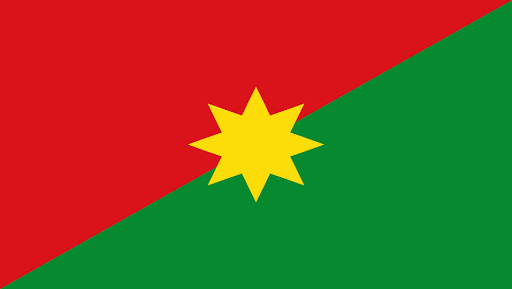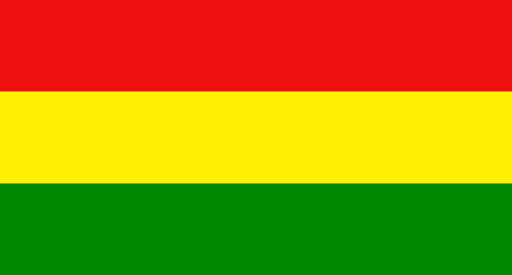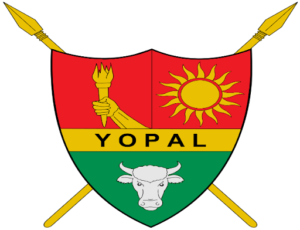Yopal
Department

Flag of the city
The flag characterized by horizontal bands—red on top, followed by yellow, and ending with green at the bottom—carries rich symbolism in its vibrant colours. The red stripe typically embodies strength, courage, and valour, potentially reflecting the passionate spirit or sacrifices of the people it represents. Central to the flag, the yellow band can be seen as a symbol of optimism, prosperity, and joy, possibly hinting at the resources or the radiant sun that graces the land. Anchoring the flag is the green hue, which universally speaks to life, fertility, and nature.

Seal of the city
Shield of the municipality of Yopal, Casanare, Colombia: A Swiss-style shield. First, in red, a torch held by a hand. Second, in red, a blazing sun in gold. Third, in gold, the name of the municipality in black letters. Fourth, in green, the front view of a bull in silver. As an external ornament, the shield features two crossed golden lances.

Slogan of the city
Yopal serves as the capital of the Casanare department in Colombia. Renowned for its pivotal contribution to Colombia’s oil sector, the city and its neighbouring areas are home to numerous oil fields. This prominence in the oil industry has led to swift urban expansion and progress in Yopal. Beyond its ties to oil, the area is also celebrated for its captivating natural vistas, spanning plains and rivers, and its deep-rooted tradition in agriculture, especially cattle farming.
History
Situated in eastern Colombia, Yopal, often referred to as El Yopal, proudly stands as the capital of the Casanare department. Its establishment traces back to 1935 when Pedro Pablo González laid the foundation of what was initially a small settlement, or “caserío”. By 1974, with the inception of the Casanare department, Yopal gained prominence as its capital. Nestled near the western fringes of the vast Llanos plains, Yopal enjoys strategic connectivity to Sogamosa in the Cordillera Oriental through a network of roads.
Traditionally, Yopal’s economic backbone has been its agricultural and livestock sectors. Expansive cattle ranches dot its landscapes, and the fertile grounds produce an array of crops such as rice, corn, coffee, sugarcane, beans, plantains, and a variety of citrus fruits. Over the years, Yopal’s significance has transcended agriculture. Since the mid-1990s, the city evolved into a pivotal hub for the petroleum industry, which fuelled a considerable population growth. This energy boom transformed Yopal into a bustling urban centre, drawing in businesses, skilled labour, and investments.
However, the city’s growth has not been without challenges. The influx of wealth from the petroleum industry inadvertently made the region a hotspot for criminal activities. Yopal and its surrounding areas witnessed a surge in violent crimes, notably fuelled by the illicit cocaine trade. Furthermore, the region became a battleground, marred by conflicts involving guerrillas and paramilitary groups. These challenges have required concerted efforts from both the local administration and national authorities to ensure safety and stability while preserving Yopal’s rich cultural and economic legacy.

Geography
Yopal boasts a population of approximately 168,000 residents and is strategically situated at an elevation of 350 metres, equivalent to 1,150 feet above sea level. Encompassing an expansive area of 2,771 square kilometres or about 1,070 square miles, this vibrant city is located roughly 387 kilometres (240 miles) from Colombia’s capital, Bogotá. The region experiences a median temperature of 26°C, which translates to a pleasant 78.8°F. Geographically, Yopal is positioned at coordinates 5°21′0″N and 72°24′36″W.

Population
168,433 (2018)
146 200 (2017)
One photo representative of the city
Situated in the bustling city of Yopal, “La Iguana Natural Park” stands as a testament to the balance between urbanization and nature preservation. Conceived from the foresight of dedicated conservationists and urban developers, the park was established to be a green refuge amid the city’s modern expansion.
As its name suggests, the park is renowned for the sizable population of iguanas that freely roam its grounds. These regal reptiles, often spotted basking in the sun or perched high up in the trees, have become emblematic of the park’s essence. Beyond iguanas, the park serves as a sanctuary for diverse bird species, turtles, and various other native creatures, making it a magnet for wildlife enthusiasts and budding photographers.
Over time, La Iguana Natural Park has transformed into more than a mere nature reserve. It doubles as Yopal’s cultural heart, regularly playing host to an array of events, workshops, and communal gatherings. Regularly scheduled educational initiatives aim to cultivate environmental consciousness, particularly among the younger generation.

Etymology
The name “Yopal” is derived from the indigenous Yopo tree (Anadenanthera peregrina). This tree is native to the region and has historical and cultural significance. The seeds of the Yopo tree have been traditionally used by various indigenous groups in ceremonial rituals for their hallucinogenic properties. The word itself likely has roots in the local indigenous languages, reflecting the deep connection between the land and its original inhabitants. Over time, as the settlement grew and evolved, it came to be known by the name “Yopal”, linking the city’s identity with this notable native tree.
What the city is known or famous for
Nestled in Colombia’s Casanare department, Yopal stands as a testament to the region’s profound cattle ranching heritage. The Llanos’ sprawling plains, upon which Yopal is situated, offer the perfect backdrop for extensive cattle farming. For generations, this city has been at the forefront of the ranching sector, which has intricately melded its societal structures, traditions, and economy. These endless pastures have fostered the growth of substantial ranching enterprises. As a result, Yopal has evolved into a vital hub for cattle commerce, drawing ranchers from various corners to partake in livestock trading. The influence of the ranching industry in Yopal is not confined to commerce alone. It spills over into the cultural realm, inspiring traditional arts, dances, and even the thrilling rodeo events that are a favourite among residents and visitors alike. Additionally, Yopal’s culinary scene proudly showcases its ranching roots, with beef dishes being a culinary staple. In essence, for Yopal’s inhabitants, cattle ranching isn’t just a livelihood—it’s an embodiment of their history, culture, and identity.
